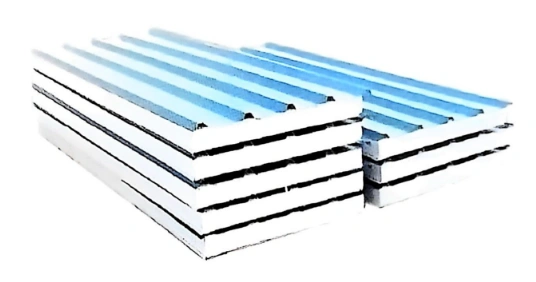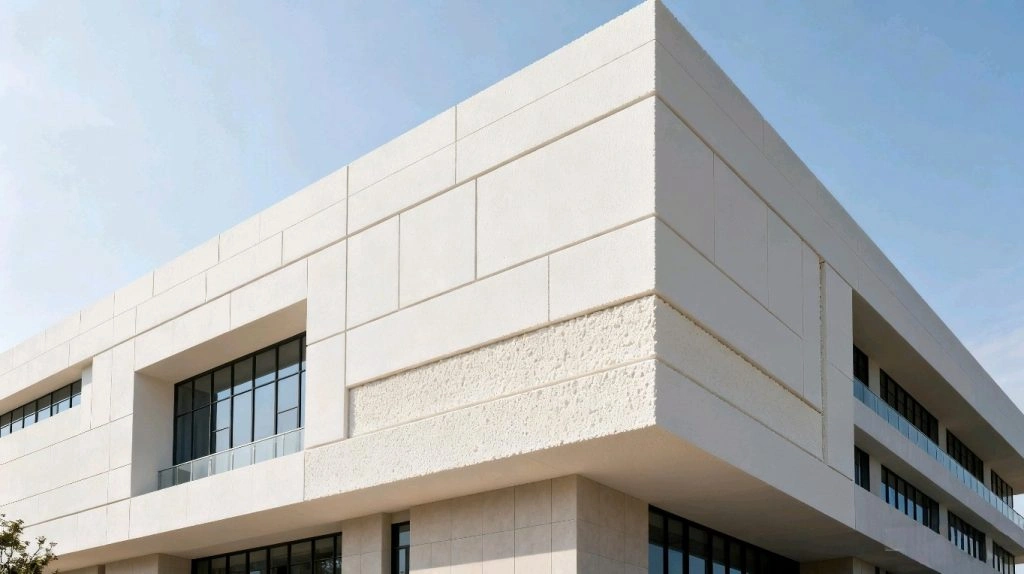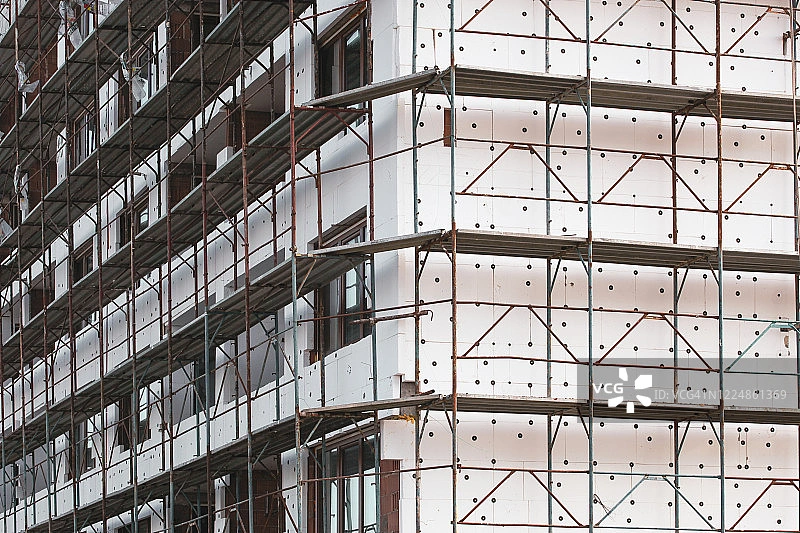Expanded Polystyrene (EPS) boards are now a solid and effective choice compared to standard rigid insulation materials. With shortages of raw materials disrupting supply chains, builders and contractors are picking EPS for its great heat-blocking ability, low cost, and many uses. EPS is approved by factory mutual, holds UL certifications, and follows building codes as a dependable product that performs well for years. This article looks at the makeup, benefits, drawbacks, and eco-friendly aspects of EPS boards. It also compares them to other common rigid insulation types.

What Are EPS Boards and How They Work as Insulation
EPS boards are created by heating polystyrene beads with steam and forming them into flat panels. Their ability to keep heat in or out comes from air trapped inside their structure.
Composition et structure des cartes EPS
EPS is made of 98% air and 2% polystyrene material. This forms a closed-cell setup that stops heat from moving. P-extra light material, a type of Common Grade EPS, works well with automatic vacuum forming machines, standard hydraulic presses, and different large molding tools.
Thermal Performance Characteristics of EPS
The air trapped in EPS greatly cuts down heat flow. EPS gives the best R-value for the money and keeps this value steady over time. Special types, like Graphite Grade EPS, lower heat flow even more. For instance, the S-33 grade has a heat flow rate below 0.033 W/m·K. Standard EPS is at 0.039 W/m·K. This makes S-33 about 15% better at blocking heat.
Comparison with Other Rigid Insulation Materials
Unlike XPS (Extruded Polystyrene) or Polyiso (Polyisocyanurate), which may need multiple layers for thickness or lose R-value over time, EPS boards can be thicker than four inches in one piece. They also hold their R-value reliably.
Evaluating the Benefits of EPS Boards
As the need for energy-saving building options grows, EPS boards show clear strengths.
Energy Efficiency and Thermal Resistance (R-Value)
The R-value measures how well a material blocks heat. EPS offers the best R-value for its price, making it a wallet-friendly option. Graphite Grade EPS boosts this efficiency further.
Lightweight and Easy Installation
Because of its low weight, EPS is super light. E-standard material, a Common Grade EPS, uses a simple foaming method to get a light structure in one go. This makes EPS easy to carry and set up, which saves on worker costs.
Cost-Effectiveness for Residential and Commercial Use
Compared to XPS or Polyiso, EPS gives similar results at a cheaper price per inch of thickness. Its variety of grades lets builders choose options that fit their budgets. This works for both homes and businesses.
Potential Limitations of EPS as an Insulation Material
While EPS is great in many situations, there are some challenges to think about when picking it.
Moisture Absorption Concerns
Some older ideas said EPS soaks up water easily. But modern EPS takes in very little water, usually less than 2% by volume. It dries fast if it gets wet. However, long exposure to water without good sealing can lower its performance.
Fire Resistance and Safety Considerations
Fire safety matters a lot for building materials. HUASHENG’s F-Flame Retardant Grade has UL certification. It meets the B2 fire safety standard, ensuring strong fire-blocking ability.
Durability Under Load and Environmental Stress
Regular EPS might bend under heavy weight or extreme heat or cold. For tough settings, stronger options like FSH-European standard Flame Retardant Grade provide over 20% more strength than other grades.
Comparing EPS with Common Rigid Insulation Alternatives
To pick the right insulation, it helps to compare EPS with other popular types, like XPS and Polyiso.
EPS vs XPS (polystyrène extrudé)
XPS is often used for its water resistance in below-ground projects.
Differences in Water Resistance and Compressive Strength
XPS might resist water a bit better at first. But EPS takes in very little water and dries quickly with proper barriers. This makes it a good rival.
Performance in Below-Grade Applications
Graphite-enhanced EPS, like the S-32 series, suits passive houses and high-efficiency buildings. It has low heat flow, below 0.032 W/m·K, and strong resistance to pressure. This makes it great for foundation walls or basements.

EPS vs. Polyiso (Polyisocyanurate)
Polyiso starts with high R-values but may lose strength over time due to gas leaking out.
R-Value Stability Over Time
EPS gives the best R-value for its cost and stays steady. Polyiso’s R-value often drops a lot after being installed.
Suitability for High-Temperature Applications
Polyiso handles high heat better. But HUASHENG’s Graphite Grade or Carbon Black Grade, like FGE-low thermal conductivity carbon polystyrene (suspension method), improves heat resistance and fire safety.
Environmental Impact of Using EPS Boards
As eco-friendly building becomes more important, knowing EPS’s environmental effects is key.
Recyclabilité et élimination en fin de vie
HUASHENG offers light, energy-saving EPS that stays strong. Their Environmental Protection Grade, made from 100% recycled EPS foam, helps reuse materials. This supports eco-friendly goals.
Manufacturing Emissions Compared to Other Materials
HUASHENG’s smart production and recycled EPS foam cut energy use by over 30% compared to making traditional insulation. This lowers the environmental footprint.
Innovations in Eco-Friendly EPS Production
HUASHENG’s Customized REPS uses 100% recycled materials and reuses over 95% of waste. This fits global green building rules and shows eco-friendly production methods.
Application Scenarios Where EPS Can Be a Suitable Choice
EPS’s range of densities and types makes it perfect for many uses.
Wall, Roof, and Floor Insulation in Residential Buildings
EPS panels give steady insulation for walls, roofs, and floors. They avoid heat leaks common in stud framing. HUASHENG’s FS-Flame Retardant Grade reaches B1 fire safety levels fast. It meets tough home building codes.
Use in EIFS (Exterior Insulation Finishing Systems)
Because they’re light and easy to shape, FB-light Flame Retardant Grade materials work well for low-density boards. They’re ideal for EIFS systems needing insulation that fits under stucco or other finishes.
Packaging, Cold Storage, and Specialty Industrial Uses
B-Rapid prototyping grade is great for packing electrical items and works with automatic forming machines. It’s also perfect for cold storage, where keeping steady temperatures is vital. This shows EPS’s use beyond building projects.
Key Factors to Consider When Choosing EPS for Insulation Projects
Before selecting EPS boards, think about these important points.
Climate Zone and Building Codes Compliance
Fire safety and R-value rules differ by area. HUASHENG’s F-Flame Retardant Grade, made with a foaming rate of 35-75 times, meets B2 standards. It ensures energy savings in various climates.
Compatibility with Other Building Materials
EPS fits with most roofing systems, including glues and membranes. Choosing the right type ensures it works well with other materials.
Long-Term Performance Expectations
Pick EPS grades that handle temperature changes. FSH-European standard Flame Retardant Grade has strong bonding and reaches B1 fire safety faster than FS. This ensures long-lasting performance.
Introduction à HUASHENG en tant que fournisseur EPS de confiance
HUASHENG leads in advanced polymer solutions. They provide top-quality EPS insulation for building needs.
Aperçu de la gamme de produits de HUASHENG
HUASHENG offers a range of EPS grades for specific projects:
Common Grade, Flame Retardant Grade, Graphite Grade
- Classe commune: Includes P-extra light material for affordable indoor insulation.
- Flame Retardant Grade: Includes F-Flame Retardant Grade, meeting B2 standards.
- Graphite Grade: Includes FGE-Graphite polystyrene (suspension method) and S-33 Graphite polystyrene (extrusion method) for top insulation.
Environmental Protection Grade, Carbon Black Grade, Customized REPS Solutions
- Environmental Protection Grade: Includes FHE-N-HBCD Flame Retardant Grade, made from 100% recyclable materials.
- Carbon Black Grade: Includes black polystyrene FGE material (suspension method) for UV resistance.
- Customized REPS: Custom solutions with specific density and reinforcements for client needs.
Engagement envers la qualité, l’innovation et la durabilité
HUASHENG follows a focus on “innovation-driven, green smart manufacturing.” Their ISO-certified methods and modern production lines provide custom EPS solutions worldwide. They balance performance and eco-friendly practices.

Conclusion
EPS boards are a strong and budget-friendly alternative to traditional rigid insulation. They offer great heat resistance, low cost, and many uses, making them ideal for builders facing material shortages. HUASHENG’s grades—Common Grade, Flame Retardant Grade, Graphite Grade, Environmental Protection Grade, Carbon Black Grade, and Customized REPS—meet various project needs with energy efficiency and durability. While moisture and fire safety need attention, proper use ensures reliability. Their eco-friendly production and recyclability support green building. For homes, businesses, or cold storage, EPS boards provide lasting value, making them a smart choice for today’s construction.
Questions fréquentes
Q1: Is Expanded Polystyrene safe for homes?
A: Yes. HUASHENG’s F-Flame Retardant Grade has UL certification. It meets strict safety rules for homes when installed correctly.
Q2: Does water hurt EPS board performance?
A: Not much, if handled right. EPS takes in little water, less than 2% by volume, and dries fast. Good sealing keeps it working well in damp places.
Q3: Can recycled EPS be as good as new EPS?
A: Yes. HUASHENG’s Environmental Protection Grade, made from 100% recycled materials, cuts energy use by about 30%. It performs just as well as new EPS.






